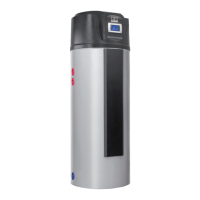3.3 Corrosion protection
(only RBW 301 PV
-S)
Oxygen always plays a role if metal materials in a
heating system corrode. The pH value and the salt
content also play a major role. A licensed plumber
who would like to be able to guarantee his cus-
tomers a hot water heating system not at risk of
corrosion from oxygen - without the use of chemi-
cals - must pay attention to the following:
n Correct system design by the heating builder/
planner and
n depending on the materials installed: filling the
heating system with demineralised soft water
or fully deionised water
, checking the pH value
after 8 to 12 weeks.
VDI 2035 applies for the system types listed below.
If the guide values for filling, replenishment and cir-
culation water are exceeded, the water must be
pre-conditioned.
Scope of application of VDI 2035:
n Domestic hot-water heating systems as per
DIN 4753 (sheet 1 only)
n Water heating systems as per DIN EN 12828
inside the building up to an inlet temperature of
100°C
n Systems that serve building complexes and
with a replenishment water volume during their
service life that is a maximum of twice the
filling water volume.
See the following table for the requirements in
accordance with VDI 2035 Part 1 with regard to
total hardness.
Total hardness [°dH] subject to the specific system volume
Total rated output in kW <20 l/kW ³20 l/kW and <50 l/kW ³50 l/kW
to 50 kW £16.8 °dH £1
1.2 °dH £0.11 °dH
The following table provides the allowed oxygen content in connection with the salt content.
Reference values for the hot water in accordance with VDI 2035 Part 2
low-salt saline
Electrical
conductivity at 25 °C
μS/cm < 100 100-1,500
Oxygen content mg/l < 0.1 < 0.02
pH value at 25 °C 8,2-10,0 *)
*) For aluminium and aluminium alloys, the pH range is restricted: pH value at 25 °C is 8.2-8.5 (max. 9.0 for
aluminium alloys)
Water treatment with chemicals
Adding chemicals to treat water should only be
done as an exception. VDI 2035 Part 2 requires
explicitly under Point 8.4.1 that all water treatment
be explained and documented in the system log
book. There is a reason for this, because unprofes-
sional use of chemicals leads:
n frequently to the failure of elastomer materials
n to blocking and sedimentation due to the
sludge that forms
n to defective anti-friction seals on pumps
n to the formation of biofilms that cause micro-
bially influenced corrosion and/or that can sub-
stantially impair thermal transfer
.
In low-salt water and the correct pH for a short
time even to oxygen concentrations up 0.5 mg /
l are tolerated.
REMKO RBW PV series
14

